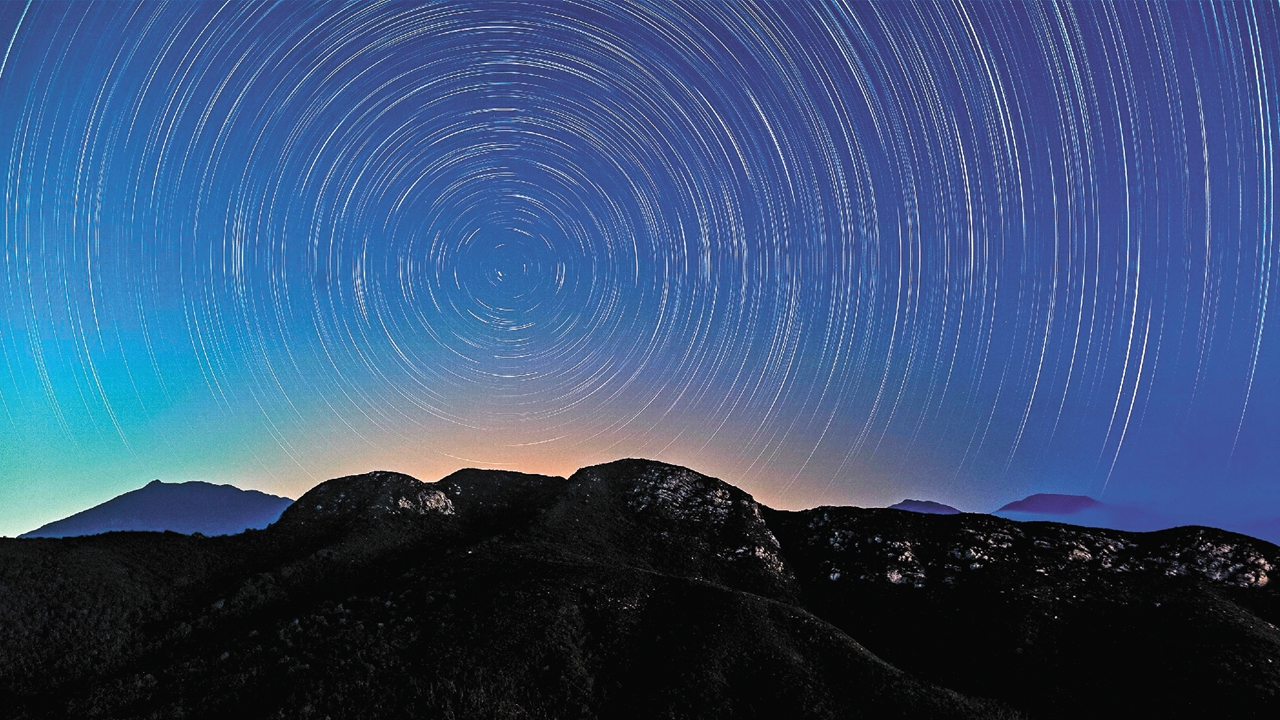A midsummer night's stargazing guide
Writer: Song Yingwen | Editor: Zhang Chanwen | From: Shenzhen Daily | Updated: 2023-07-24

Star trails over the mountains in Xichong. Li Delai
On July 13, the Shenzhen Astronomical Observatory released its first stargazing map, recommending the best venues for stargazing in Xichong, Dapeng Peninsula as well as the highlights for summer stargazing.
Xichong became China’s first International Dark Sky Community in March. Since then, outdoor lighting systems in the area have been refitted to produce warmer and softer light that gives prominence to the natural dark night environment and starry sky. Shenzhen sees this as an opportunity to build the Dapeng Starry Sky Park, improve lighting in Xichong and Dongchong, and address light pollution from the sea.
The map, a guide to a fascinating summer event, invites visitors to appreciate the beautiful night sky.

The Shenzhen Astronomical Observatory against the starry sky in Shenzhen. Lai Huisheng
Where to go
Xinwu Village and Yashan Village
These two villages, closest to the Shenzhen Astronomical Observatory, offer a variety of accommodations and dining options with well-developed facilities. The recommended stargazing spots here are found along walking trails and roads, ensuring easy access for naked-eye stargazing. This area also serves as an ideal location for astrophotography, with the observatory serving as a picturesque backdrop.
To capture the image of a full moon, go to Ligao Park and Heya Road. These places are the best locations where one can capture a captivating image of the observatory and the moon in perfect alignment.
Convenient parking options in the vicinity include the Yashan Village entrance parking lot, the Xinwu Village entrance parking lot, Hesou Village, and the Nanmentou parking lot.
Xiyangwei Village, Getian Village, and Nanshe Village
These three villages stand out as some of the finest spots within the community for stargazing.
Located away from the community commercial center, this area has the perfect dark sky to offer. The tradeoff for this remoteness is that visitors are also away from the comfort of amenities.
The area encompasses expansive, undeveloped regions with flat lands and natural woods, making it ideal for seasoned stargazers seeking to engage in activities such as deep space and time-lapse photography of the night sky.
Parking lots can be found in Getian Village and Xiyangwei Village.

A map of the Xichong Dark Sky Community. Recommended stargazing areas are highlighted in green in the map. Courtesy of Shenzhen Astronomical Observatory
What to look for
Summer Milky Way
The summer season offers the best opportunity to witness the majestic beauty of the Milky Way. When night falls, look toward the southeastern part of the sky to behold its splendor. For the best experience, be patient as the Milky Way ascends to a higher position, especially at recommended stargazing locations.
As you gaze with the unaided eye, you will notice a portion of the night sky that appears veiled by a delicate shroud of mist or clouds. However, when you employ long exposure techniques with a camera, the wondrous details of the Milky Way are revealed in stunning clarity. Furthermore, the longer you immerse yourself in the darkness, the more your eyes will adapt, allowing you to perceive the Milky Way in all its brilliance.
Planets
Summer is the best season to observe various planets.
Venus, known for its dazzling brightness, will be visible in the western sky in July but will gradually move closer to the horizon by early August. Towards the end of August, early risers can spot Venus as a bright star in the low eastern sky, as it transitions from the evening star to the morning star.
Saturn, another captivating planet, will rise from the eastern horizon around 9 p.m. in July. As the summer progresses, the rising time of Saturn will gradually advance, providing more observation opportunities.
Saturn will reach opposition — the point where it lies directly opposite the Sun, on Aug. 27, making it an ideal time to use an astronomical telescope to observe its prominent rings, including the Cassini Division and the Encke Division for experienced observers.
Jupiter, a majestic planet, can be seen rising from the northeastern horizon around 1 a.m. in July, and by August, it will rise around 11 p.m.
Observing Jupiter during the summer is best done after midnight. With the aid of an astronomical telescope, one can observe Jupiter’s four Galilean moons and the planet’s distinct bands.
Perseid meteor shower
The Perseid meteor shower is the most-anticipated celestial event this summer. As per the forecast provided by the International Meteor Organization, the peak of this magnificent spectacle will grace the evening sky Aug. 13.
Given the inherent unpredictability of meteor showers, it is advisable to tune in to the show a day or two prior to and following the peak. Anticipated to reach an estimated Zenithal Hourly Rate (ZHR) of approximately 100, this occurrence presents an exceptionally precious opportunity for observation, unmarred by any lunar luminosity.
Dos and don’ts
Minimize white light after dark to allow your eyes to adapt to darkness for optimal stargazing. Avoid using white light flashlights, bright lights, or flash photography. If lighting is necessary, use dimmed red lights with consent from others. Avoid driving vehicles to stargazing areas and set up equipment before sunset.
Leave no trace and take your trash with you. Many outdoor stargazing spots have minimal maintenance and rely on the responsible actions of stargazers for cleanliness.
Prioritize safety at night. Be aware of potential hazards such as mosquitoes, snakes, and ants.
Stay warm by dressing appropriately for the nighttime conditions. Choose a safe stargazing location and familiarize yourself with the area during daylight hours to identify potential obstacles such as ponds or slopes to avoid accidents in the dark.